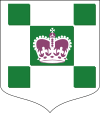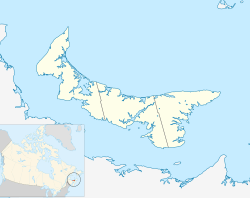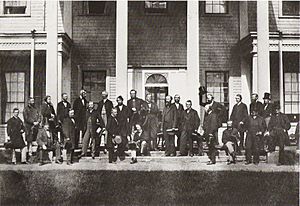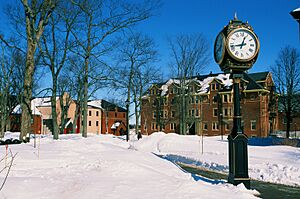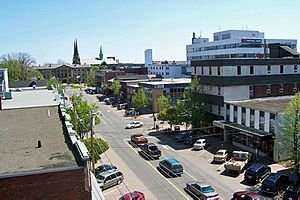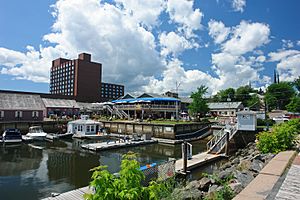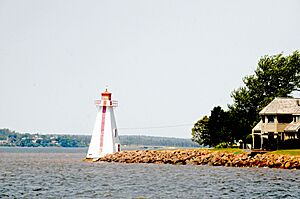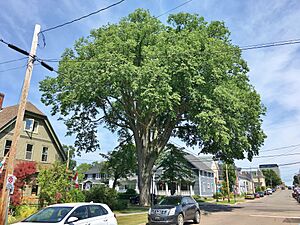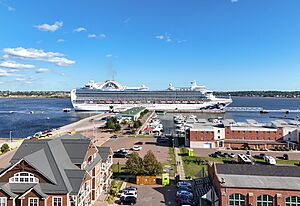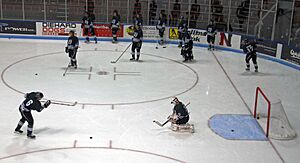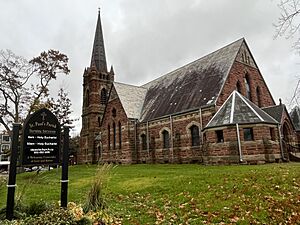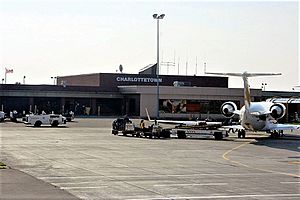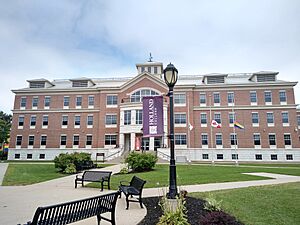Charlottetown facts for kids
Quick facts for kids
Charlottetown
|
|||||
|---|---|---|---|---|---|
|
City
|
|||||
| City of Charlottetown | |||||
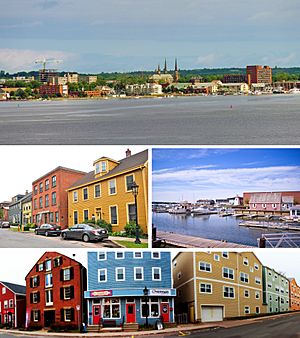
From top, left to right: Charlottetown skyline from Fort Amherst, Water Street in Downtown Charlottetown, Charlottetown Harbour, Queen's Square
|
|||||
|
|||||
| Nickname(s):
"Birthplace of Confederation"
|
|||||
| Motto(s): | |||||
| Country | Canada | ||||
| Province | Prince Edward Island | ||||
| County | Queens | ||||
| Founded | 1764 | ||||
| City | April 17, 1855 | ||||
| Named for | Charlotte of Mecklenburg-Strelitz | ||||
| Area
(2021)
|
|||||
| • City | 44.27 km2 (17.09 sq mi) | ||||
| • Urban | 57.56 km2 (22.22 sq mi) | ||||
| • Metro | 1,112.43 km2 (429.51 sq mi) | ||||
| Elevation | Sea Level to 49 m (0 to 161 ft) | ||||
| Population
(2021)
|
|||||
| • City | 38,809 | ||||
| • Density | 876.6/km2 (2,270/sq mi) | ||||
| • Urban | 52,390 | ||||
| • Urban density | 910.2/km2 (2,357/sq mi) | ||||
| • Metro | 78,858 | ||||
| • Metro density | 70.9/km2 (184/sq mi) | ||||
| • Change (2016–21) | |||||
| • Estimate (2022) | 40,500 | ||||
| Demonym(s) | Charlottetonian, Townie, From Town | ||||
| Time zone | UTC−04:00 (AST) | ||||
| • Summer (DST) | UTC−03:00 (ADT) | ||||
| Postal code |
C1A — E
|
||||
| Area codes | 902 and 782 | ||||
| NTS Map | 011L03 | ||||
| Federal Riding | Charlottetown | ||||
Charlottetown is the capital city of Prince Edward Island, a province in Canada. It is also the largest city on the island. The city is named after Queen Charlotte. Charlottetown became an official city in 1855.
A very important meeting happened here in 1864. It was called the Charlottetown Conference. Leaders from different parts of British North America met to talk about joining together. This meeting helped start the country of Canada in 1867. Prince Edward Island joined Canada a bit later, in 1873. Because of this, Charlottetown is known as the "Birthplace of Confederation." Its motto, Cunabula Foederis, means "Birthplace of Confederation" in Latin.
About 40,500 people live in Charlottetown (as of 2022). If you include the nearby areas, the population is around 83,063 (as of 2021). This means about half of everyone in Prince Edward Island lives in or near Charlottetown.
Contents
History of Charlottetown
Early Times (1720–1900)
The first European people to settle here were the French in 1720. They built a settlement called Port La Joye. It was across the harbour from where Charlottetown is today.
During a war called King George's War, the British took control of Prince Edward Island. But a French officer and 500 men attacked them. The British were defeated in the Battle at Port-la-Joye.
In 1758, during the French and Indian War, the British took over the island again. They sent many French settlers away. The British then built Fort Amherst to protect the harbour.
In 1764, Charlottetown was chosen to be the main town for Queens County. A year later, it became the capital of St. John's Island. The streets and public squares you see today were planned between 1768 and 1771. The town was named to honour Queen Charlotte.

During the American Revolution in 1775, American privateers attacked Charlottetown. They stole the colony's official seal. They also took some important people prisoner, but later let them go.
In 1798, St. John's Island was renamed Prince Edward Island. This was to honour Prince Edward, Duke of Kent and Strathearn.
In 1805, the British built a fort called "Fort Edward" to defend the harbour. In 1835, a building called "Government House" was built. It was for the island's governor. Today, it is still the official home for the Lieutenant Governor.
A new building for the government was built between 1843 and 1847. It was first called the Colonial Building. After Canada was formed, it became known as "Province House". This building is very important to the city's history. It is still used by the government today. It is also a National Historic Site.
On April 17, 1855, Charlottetown officially became a city. It had about 6,500 people at that time.
From September 1 to 8, 1864, Charlottetown hosted the Charlottetown Conference. Many important meetings about forming Canada happened at Province House. There were also social events around the city.
Prince Edward Island joined Canada on July 1, 1873. Besides being the government's home, Charlottetown was known for building ships and cutting lumber. It was also a fishing port. But the shipbuilding industry became less important later in the 1800s.

In 1873, a park called Victoria Park was created. It was named after Queen Victoria.
In 1874, the Prince Edward Island Railway opened a train line between Charlottetown and Summerside. The railway and shipping helped the city's waterfront grow. The first hospital, the Charlottetown Hospital, opened in 1879. Another public hospital, the Prince Edward Island Hospital, opened in 1884.
Modern Times (1900–present)
Religion was very important in how Charlottetown's schools and hospitals grew. There were separate schools and hospitals for different religious groups. For example, Prince of Wales College and St. Dunstan's University were different colleges.
Cars changed how Charlottetown grew in the 1900s. More houses were built in areas that used to be farms. The Charlottetown airport was improved during World War II. It was used for training pilots. After the war, it became Charlottetown Airport. Charlottetown's shipyards were also used a lot during World War II. They fixed and upgraded many Canadian warships. More houses were built in nearby areas after the war.
In 1959, the village of Spring Park joined the city. This made Charlottetown bigger.
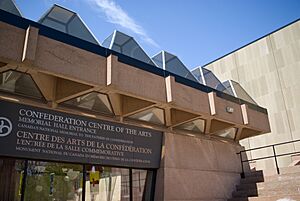
To celebrate 100 years since the Charlottetown Conference, a national monument was built. The Confederation Centre of the Arts opened in 1964. It has a public library, an art gallery, and a theatre. The theatre hosts the Charlottetown Festival every summer.
In the 1960s, new schools were built. In 1969, the University of Prince Edward Island (UPEI) was formed. It combined two older colleges. UPEI is now on the old St. Dunstan's University campus. The Department of Agriculture and Agri-Food also has a research farm nearby. These two areas create a large green space in the city. The old Prince of Wales College became part of Holland College.
The Queen Elizabeth Hospital opened in 1982. In 1983, the main office for Veterans Affairs Canada moved to Charlottetown. In 1986, UPEI opened the Atlantic Veterinary College.
More offices and shops were built in the 1970s and 1980s. A hotel and convention center opened in 1982. This helped bring new businesses to the downtown area. Train service ended in 1989. The old railway lands by the water became parks and attractions.
In the late 1990s and 2000s, large stores opened in the northern parts of the city. These "big box" stores changed how people shopped.
On April 1, 1995, Charlottetown became much larger. It joined with several nearby towns and villages. These included Parkdale, Sherwood, and Winsloe. Today, the city covers parts of two townships.
The downtown area continues to grow with new offices. However, some shops have moved to the new areas with big box stores.
In 2021, the Charlottetown City Council voted to remove a statue of John A. Macdonald. He was Canada's first Prime Minister. This decision came after a year of vandalism and the discovery of a mass grave at a former residential school in British Columbia.
Geography
Charlottetown is on its own harbour. This harbour is where three rivers meet on the island's south shore. The harbour opens into the Northumberland Strait. The city is shaped like a "V" pointing south. It is bordered by the North (Yorke) River and the Hillsborough (East) River.
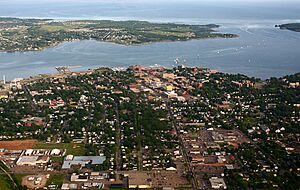
Climate
Charlottetown has a humid continental climate. This means it has warm summers and cold winters. But its location near the water makes the weather a bit milder. In January, the average temperature is about -7.3°C. It can get colder than -20°C about 5-6 days a year. Winters have a lot of snow, about 284.8 cm per year.
Spring warms up slowly because the ocean water is still cold. Summers are mild, with July highs around 23.6°C. The city gets about 1135.7 mm of rain and snow each year. Most of this falls in late fall and winter.
The hottest temperature ever recorded was 36.7°C on August 19, 1935. The coldest was -32.8°C on January 29, 1877.
| Climate data for Charlottetown Airport, 1991–2020 normals, extremes 1872–present | |||||||||||||
|---|---|---|---|---|---|---|---|---|---|---|---|---|---|
| Month | Jan | Feb | Mar | Apr | May | Jun | Jul | Aug | Sep | Oct | Nov | Dec | Year |
| Record high humidex | 16.8 | 14.0 | 26.1 | 25.9 | 34.4 | 39.7 | 40.6 | 41.0 | 39.8 | 32.8 | 26.4 | 19.2 | 41.0 |
| Record high °C (°F) | 15.1 (59.2) |
13.3 (55.9) |
24.5 (76.1) |
26.7 (80.1) |
31.7 (89.1) |
32.2 (90.0) |
33.9 (93.0) |
36.7 (98.1) |
31.5 (88.7) |
27.8 (82.0) |
21.3 (70.3) |
16.7 (62.1) |
36.7 (98.1) |
| Mean daily maximum °C (°F) | −3.0 (26.6) |
−2.9 (26.8) |
1.4 (34.5) |
7.3 (45.1) |
14.2 (57.6) |
19.5 (67.1) |
23.6 (74.5) |
23.3 (73.9) |
19.1 (66.4) |
12.6 (54.7) |
6.7 (44.1) |
0.9 (33.6) |
10.2 (50.4) |
| Daily mean °C (°F) | −7.3 (18.9) |
−7.3 (18.9) |
−2.6 (27.3) |
3.0 (37.4) |
9.1 (48.4) |
14.6 (58.3) |
19.0 (66.2) |
18.8 (65.8) |
14.6 (58.3) |
8.6 (47.5) |
3.2 (37.8) |
−2.7 (27.1) |
5.9 (42.6) |
| Mean daily minimum °C (°F) | −11.5 (11.3) |
−11.6 (11.1) |
−6.5 (20.3) |
−1.4 (29.5) |
3.9 (39.0) |
9.6 (49.3) |
14.4 (57.9) |
14.1 (57.4) |
10.0 (50.0) |
4.6 (40.3) |
−0.2 (31.6) |
−6.3 (20.7) |
1.6 (34.9) |
| Record low °C (°F) | −32.8 (−27.0) |
−30.6 (−23.1) |
−27.2 (−17.0) |
−16.1 (3.0) |
−6.7 (19.9) |
−1.3 (29.7) |
2.8 (37.0) |
2.0 (35.6) |
−1.4 (29.5) |
−6.7 (19.9) |
−17.2 (1.0) |
−28.1 (−18.6) |
−32.8 (−27.0) |
| Record low wind chill | −50.2 | −45.4 | −36.0 | −24.5 | −11.1 | −3.3 | 0.0 | 0.0 | −1.9 | −10.8 | −24.1 | −40.6 | −50.2 |
| Average precipitation mm (inches) | 101.4 (3.99) |
85.4 (3.36) |
83.9 (3.30) |
74.8 (2.94) |
78.3 (3.08) |
90.7 (3.57) |
82.3 (3.24) |
96.3 (3.79) |
95.3 (3.75) |
121.8 (4.80) |
110.3 (4.34) |
115.2 (4.54) |
1,135.7 (44.71) |
| Average rainfall mm (inches) | 35.4 (1.39) |
29.8 (1.17) |
45.2 (1.78) |
50.1 (1.97) |
76.1 (3.00) |
90.7 (3.57) |
82.3 (3.24) |
96.3 (3.79) |
95.3 (3.75) |
120.2 (4.73) |
91.9 (3.62) |
58.3 (2.30) |
871.6 (34.31) |
| Average snowfall cm (inches) | 73.2 (28.8) |
61.7 (24.3) |
41.9 (16.5) |
21.4 (8.4) |
2.2 (0.9) |
0.0 (0.0) |
0.0 (0.0) |
0.0 (0.0) |
0.0 (0.0) |
1.5 (0.6) |
20.5 (8.1) |
62.5 (24.6) |
284.8 (112.1) |
| Average precipitation days (≥ 0.2 mm) | 19.4 | 15.7 | 16.3 | 14.8 | 13.7 | 12.6 | 13.0 | 11.3 | 12.6 | 15.7 | 16.7 | 19.4 | 181.1 |
| Average rainy days (≥ 0.2 mm) | 5.9 | 4.9 | 7.9 | 10.9 | 13.5 | 12.6 | 13.0 | 11.3 | 12.6 | 15.4 | 13.0 | 9.0 | 129.7 |
| Average snowy days (≥ 0.2 cm) | 17.7 | 14.1 | 12.6 | 6.2 | 0.7 | 0.0 | 0.0 | 0.0 | 0.0 | 0.1 | 6.4 | 14.7 | 73.4 |
| Average relative humidity (%) (at 15:00 LST) | 73.9 | 70.1 | 67.7 | 63.9 | 62.3 | 64.8 | 64.7 | 63.7 | 65.4 | 68.5 | 73.0 | 76.3 | 67.9 |
| Mean monthly sunshine hours | 108.9 | 109.1 | 141.3 | 148.2 | 197.1 | 219.8 | 253.6 | 219.0 | 181.0 | 123.9 | 62.9 | 75.8 | 1,840.5 |
| Percent possible sunshine | 38.8 | 37.6 | 38.3 | 36.5 | 42.5 | 46.6 | 53.2 | 49.9 | 47.9 | 36.5 | 22.1 | 28.1 | 39.8 |
| Source: Environment Canada (sun 1971–2000) | |||||||||||||
Cityscape
Downtown Charlottetown has many old houses and buildings. It also has a waterfront area along the harbour. Areas around downtown like Brighton and Spring Park have grown a lot.
The outer parts of the city still have many farms. There is also a large research farm in the middle of the city. This farm creates a big green space.
The city's main roads for shops and businesses are:
- University Avenue/Malpeque Road
- North River Road/Lower Malpeque Road
- St. Peter's Road
- Mount Edward Road
- Kensington Road
The main streets in the downtown area are:
- Queen Street
- Water Street
- Grafton Street
Neighbourhoods
Charlottetown is made up of several neighbourhoods. These used to be separate towns or villages.
- Downtown Charlottetown
- Brighton
- Spring Park
- Parkdale
- Sherwood (including Falconwood)
- East Royalty (including Hillsborough Park)
- West Royalty (including Lewis Point)
- Winsloe
In 1996, Charlottetown joined with Parkdale, Sherwood, and other communities. This made the city much bigger. There is a green belt around the northern edge of the city. This is meant to stop too much building.
Culture
Attractions
Charlottetown has many interesting places to visit. The old houses and buildings in the downtown area are popular. The waterfront has also been improved with walking trails and parks. A new cruise ship terminal opened in 2007. This helps more cruise ships visit the city.
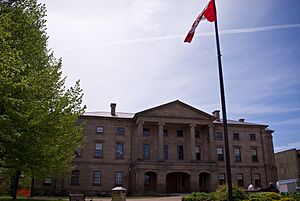
Popular places to see include Province House. This is where the Charlottetown Conference took place. Another place is Founders Hall. It is an old railway building that now has exhibits about Canada's history.
The Confederation Centre of the Arts offers live theatre shows. This includes the Charlottetown Festival in the summer. It also has an art gallery. The main show at the festival is Anne of Green Gables - The Musical. This musical is based on the famous book by Island author Lucy Maud Montgomery. There are also other small theatres and galleries nearby.
Charlottetown has 11 National Historic Sites of Canada. These include Province House and the Confederation Centre of the Arts.
Sports
Charlottetown has many parks and fields for sports. You can play soccer, baseball, football, rugby, and field hockey. Cricket is also becoming popular. There are also tennis courts, trails, and running tracks. Most schools have gyms that the public can use. There are also hockey arenas and swimming pools.
High schools like Colonel Gray and Charlottetown Rural have sports teams. The University of Prince Edward Island (UPEI) has varsity teams called the UPEI Panthers. Holland College also has teams called the Holland Hurricanes.
The city has a junior hockey team called the Charlottetown Islanders. It also has a basketball team called the Island Storm.
Charlottetown has hosted big sports events, including:
- 1991 Canada Winter Games
- 2009 Canada Summer Games (with Summerside)
Demographics
| Federal census population history of Charlottetown (post-amalgamation) | ||
|---|---|---|
| Year | Pop. | ±% |
| 1991 | 31,541 | — |
| 1996 | 32,531 | +3.1% |
| 2001 | 32,245 | −0.9% |
| 2006 | 32,174 | −0.2% |
| 2011 | 34,562 | +7.4% |
| 2016 | 36,094 | +4.4% |
| 2021 | 38,809 | +7.5% |
| Source: Statistics Canada |
||
|
||||||||||||||||||||||||||||||||||||||||||||||||||||||||||||
In 2021, Charlottetown had a population of 38,809 people. This was a 7.5% increase from 2016. The city covers an area of 44.27 square kilometers.
About 3.9% of the people in Charlottetown are under five years old. About 21% are retirement age. The average age in Charlottetown is 40.8 years.
There are 17,193 homes in Charlottetown. The average value of a home is $200,284.
In 2021, 5,245 people living in Charlottetown were immigrants. This means they were born outside Canada. The top countries they came from were China, India, Vietnam, and Syria.
Ethnicity
Most people in Charlottetown are white (about 76.2%). About 21.8% are visible minorities, and 2.0% are Indigenous. The largest visible minority groups are South Asian, Chinese, Black, Arab, and Southeast Asian.
| Panethnic group | 2021 | 2016 | 2011 | 2006 | 2001 | |||||
|---|---|---|---|---|---|---|---|---|---|---|
| Pop. | % | Pop. | % | Pop. | % | Pop. | % | Pop. | % | |
| European | 28,670 | 76.25% | 29,940 | 86.11% | 30,035 | 90.15% | 29,875 | 95.46% | 30,320 | 97.15% |
| South Asian | 2,390 | 6.36% | 660 | 1.9% | 340 | 1.02% | 70 | 0.22% | 60 | 0.19% |
| East Asian | 2,035 | 5.41% | 1,955 | 5.62% | 1,560 | 4.68% | 200 | 0.64% | 150 | 0.48% |
| Southeast Asian | 1,195 | 3.18% | 340 | 0.98% | 165 | 0.5% | 15 | 0.05% | 30 | 0.1% |
| African | 1,090 | 2.9% | 490 | 1.41% | 255 | 0.77% | 260 | 0.83% | 140 | 0.45% |
| Middle Eastern | 1,075 | 2.86% | 630 | 1.81% | 480 | 1.44% | 290 | 0.93% | 155 | 0.5% |
| Indigenous | 745 | 1.98% | 560 | 1.61% | 300 | 0.9% | 450 | 1.44% | 280 | 0.9% |
| Latin American | 240 | 0.64% | 120 | 0.35% | 130 | 0.39% | 115 | 0.37% | 70 | 0.22% |
| Other/multiracial | 165 | 0.44% | 95 | 0.27% | 40 | 0.12% | 10 | 0.03% | 20 | 0.06% |
| Total responses | 37,600 | 96.88% | 34,770 | 96.33% | 33,315 | 96.39% | 31,295 | 97.27% | 31,210 | 96.79% |
| Total population | 38,809 | 100% | 36,094 | 100% | 34,562 | 100% | 32,174 | 100% | 32,245 | 100% |
| Note: Totals greater than 100% due to multiple origin responses | ||||||||||
| Ethnic Origin | Population | Percent |
|---|---|---|
| Scottish | 11,650 | 31.0% |
| Irish | 10,140 | 27.0% |
| English | 9,830 | 21.0% |
| Canadian | 4,595 | 12.2% |
| French n.o.s | 4,120 | 11.0% |
| Chinese | 1,765 | 4.7% |
| German | 1,520 | 4.0% |
| Indian (India) | 1,465 | 3.9% |
| Acadian | 1,460 | 3.9% |
| Caucasian (White) n.o.s | 1,320 | 3.5% |
| Dutch | 850 | 2.3% |
Language
Most people in Charlottetown (78.6%) speak English as their first language. Other common first languages are Chinese (4.3%), Punjabi (2.0%), French (1.8%), Arabic (1.7%), and Vietnamese (1.2%).
Religion
As of 2021, about 57.6% of people in Charlottetown are Christians. This is down from 75.4% in 2011. About 33.0% of people do not have a religion. There are also many Muslims (3.4%) and Sikhs (1.7%).
Economy
Charlottetown's economy mainly relies on the government. The provincial, federal, and city governments are big employers. Health care and education (schools and colleges) also provide many jobs. Technology companies are growing, but many of these are call centers. Other important jobs are in light manufacturing, like chemicals and biotechnology.
Transportation
Charlottetown used to be the center of the island's railway network. Now, it is the main point for many important roads. Route 1, the Trans-Canada Highway, goes through the northern part of the city. It connects Charlottetown to the Confederation Bridge in the west and the ferry terminal in the east. Route 2, the main east-west highway, also crosses Route 1 in the city.
Charlottetown Airport is the only airport in Prince Edward Island with regular passenger flights. It serves about 280,000 passengers each year.
Charlottetown Transit started in 2005. It has 10 bus routes around the city.
For many years, Charlottetown did not have public transit. This meant most people used their own cars. The city built large parking garages downtown for workers' cars. There were also more taxis than average, as they were a common way to get around without a car.
The Charlottetown Harbour Authority runs the city's port. They are making the marine terminal bigger. The main activities at the port are bringing in gravel for building and oil products.
Education
Public schools (Kindergarten to Grade 12) in Charlottetown are managed by the Public Schools Branch. French public schools are managed by the Commission scolaire de langue française.
The city also has two private schools: Immanuel Christian School and Grace Christian School.
Charlottetown is home to the University of Prince Edward Island (UPEI). UPEI offers many programs, including Arts, Education, Science, Business, Nursing, and Engineering. The university also has the Atlantic Veterinary College.
Charlottetown also has several campuses of Holland College. This is the province's community college. There are also other private training colleges in the city.
Media
Notable people
- Milton Acorn, former poet
- Jared Connaughton, Olympic athlete
- Dorothy Corrigan, first and only female mayor of Charlottetown
- Lloyd Duffy, jockey
- Mike Duffy, Canadian senator and television journalist
- Kara Grant, Canadian pentathlon Olympian, 2004 Summer Olympics
- Dylan Mohan Gray, filmmaker
- Vern Handrahan, former professional baseball player, Kansas City Athletics
- Wally Hennessey, harness racing driver
- Bonnie Henry, provincial officer, British Columbia Ministry of Health
- Ross Johnston, professional ice hockey player, New York Islanders
- Lorie Kane, professional LPGA golfer
- Joey Kitson, Celtic rock musician and lead singer, Rawlins Cross
- Troy Little, comic book artist, graphic designer, creator of Chiaroscuro
- Whitney Rose, country musician
- Al MacAdam, former professional ice hockey player, Minnesota North Stars, Philadelphia Flyers, and Vancouver Canucks
- Amber MacArthur, Canadian television personality and author
- David MacEachern, Olympic gold medalist bobsled, 1998 Winter Olympics
- Zack MacEwen, professional ice hockey player, Ottawa Senators
- Charles Andrew MacGillivary, Medal of Honor recipient for action with the U.S. Army during World War II
- Martha MacIsaac, actress
- Tara MacLean, singer-songwriter
- Cynthia MacLeod, fiddler
- Elizabeth S. MacLeod, poet
- Don McDougall, former president, Labatt Brewing Company
- Adam McQuaid, former professional ice hockey player, Boston Bruins, Columbus Blue Jackets, and New York Rangers
- Sarah Newcomb Merrick, teacher, writer, businessperson, and physician
- Don Messer, fiddler and radio and TV show host, Don Messer's Jubilee
- Lucy Maud Montgomery, author
- Heather Moyse, Olympic gold medalist in bobsledding, 2010 and 2014 Winter Olympics
- Chris Murphy, rock musician, Sloan
- Gary Simmons, former professional ice hockey player, California Golden Seals, Cleveland Barons, and Los Angeles Kings
- Frederick Thornton Peters, Victoria Cross recipient for action off the coast of Algeria during World War II
- Jackie Torrens, comedian, Made in Canada, actor, writer, and journalist
- Jonathan Torrens, actor, writer, and producer
- Brian Tracy, self-development author and board member, The Heritage Foundation
- Rick Vaive, former professional ice hockey player, Toronto Maple Leafs and other teams
- William Henry Weeks, former architect in California
- James Wood, former Commander of the Royal Canadian Navy
See also
 In Spanish: Charlottetown para niños
In Spanish: Charlottetown para niños



